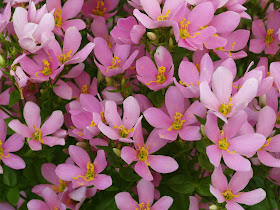On this very weekend ten years ago, the legendary Chicago region botanist Floyd Swink was honored at a memorial service at the Indiana Dunes State Park. Ken Dritz shared this limerick, pasted below, which he had "written" in his mind on the drive from Chicago. I am always reminded of it (and Floyd) when I see Deptford Pink.

A Light-Hearted Tribute, in Limerick Form,
to the Wit and Wisdom of Floyd Swink
Inspired by His Penchant for Puns
Inspired by His Penchant for Puns
by
Kenneth W. Dritz
29 October 2000
29 October 2000
Chickadee? Meadowlark? Bobolink?If we needed to know, we asked Swink.
Ev’ry bird this man knew;
Ev’ry flow’ring plant, too.
“You have there,” he might say, “Deptford Pink.”
As for fun, there was never a void.
For a pun lived this clever man, Floyd.
In the spirit of Marx
He would hold up a Lark/s-
pur and ask, “What is this—plant or boid?”
“If you mix plants and birds,” proclaimed he,
“You won’t know if you have Partridge PeaOr just old Crowfoot Grass.”
Now he’s left us, alas.
Wit and wisdom are his legacy.
“You have there,” he might say, “Deptford Pink.”
As for fun, there was never a void.
For a pun lived this clever man, Floyd.
In the spirit of Marx
He would hold up a Lark/s-
pur and ask, “What is this—plant or boid?”
“If you mix plants and birds,” proclaimed he,
“You won’t know if you have Partridge PeaOr just old Crowfoot Grass.”
Now he’s left us, alas.
Wit and wisdom are his legacy.

























+of+Calopogon+tuberosus-w-bee-6-25-08.JPG)



















